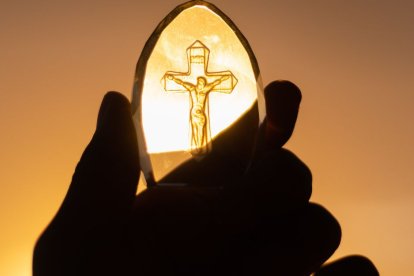The new faces of Christianity
The number of African and Latin American believers exceeds the number of European believers and increases their social, economic and political weight.

(
"The peripheries," as Pope Francis calls them, have become the center of Christianity in the 21st century. While the number of believers in Jesus Christ continues to grow each year, the latest statistics show that the prototypical white European Christian has become a minority since the rise of indigenous, African, Hispanic American and Asian Christians. In addition, there has been an explosion of new evangelical "spiritual churches" all over the world that don't have ties to traditional churches.
In the year 1900, Christians in Europe made up 68% of the total population. A century later they make up just 21%. During this period, the greatest increase has been in Africa, where believers have gone from 9% of the world's population to nearly 30% today. Currently, more than 718 million Africans are Christians, making it the continent with the largest number of believers. There are currently 2.6 billion believers, up from about 560 million at the beginning of the last century, according to data provided by the Center for the Study of Global Christianity.
Today, one out of every three people in the world is Christian
Latin America, with 611 million people, is the region with the second-largest number of Christians in the world. Europe comes in third, with 566 million, while Asia has just over 400 million. North America, where the growth of believers has been slowest since 2000, has almost 272 million Christians. These figures also indicate that the overwhelming majority of Christians live in the Southern Hemisphere (nearly 1.8 billion million compared to 838 million in the North).
Today, one out of every three people in the world is a Christian. The trend, according to the study World Christianity 2023: A Gendered Approach, published in the International Bulletin of Missionary Research, shows that the number of Christians will continue to grow in the coming years, to over 3.3 billion in 2050. This report further states that Christianity "can be considered a women's movement because women are more likely than men to identify themselves as Christians, participate in Christian activities and actively pass on the faith to the next generation."
Evangelicals are the fastest-growing Christians
Among the various denominations, the Catholic Church remains the one with the largest number of followers, with nearly 1.4 billion total baptized believers in 2021, according to the Statistical Yearbook of the Church published that year. This is followed by Pentecostals/Charismatics (679,085,000), Protestants (615,676,000), Independents (414,526,000), Evangelicals (406,886,000), Orthodox (290,594,000) and non-denominational Christians (121,400,000).
In statements to The New York Times Sam George, director of the Global Diaspora Institute at Wheaton College, explained that "Christianity at the beginning of the 21st century is the most global, the most diverse and the most dispersed faith. Christianity is getting a new face. It is getting more Black and brown and yellow." In his book The Unexpected Christian Century, Scott Sunquist insists that many of the new protagonists come from indigenous "spiritual churches" whose rise came after the departure of the colonial powers from their territory.
Megachurches are becoming a new reality
These new Christian realities are forming into huge congregations that scholars call megachurches. Asia is home to several of those with the largest number of followers. The largest is Yoido Full Gospel Church in Seoul, which has 480,000 parishioners. The second largest church based on the number of churchgoers is the Living Faith Church (275,000) which is located in Nigeria. In Latin America, several have 50,000 parishioners. In Europe, the largest megachurch has less than 10,000 believers (Faith Church, with 8,000, in Hungary), while Hillsong Church, in Sydney, is the biggest one in Australia.
Another phenomenon worth mentioning is that it is becoming increasingly difficult to establish rigid boundaries between different denominations. In many cases, the same church presents notable peculiarities depending on the region and population or the influences of other faiths. George points out that "sometimes Catholics are more evangelical and Pentecostal" in Brazil or Argentina than even typical white evangelicals in the United States.
Immigration is a determining factor
One of the most important factors of this new reality of believers is immigration. The countries where Christians are currently the most faithful are the ones with the highest number of emigrants to the West. This has fundamental demographic connotations, the effects of which are already being felt around the world. For example, the evangelical churches with the largest followings in England and France are led by African or Afro-Caribbean pastors.
In the U.S., immigration accounted for 80% of population growth in 2022. A large number of those immigrants are Hispanics. They make up almost 20% of the country's inhabitants. The Atlantic reported in 2021 that evangelical Latinos are the fastest-growing Christian group. In addition, the article states that Latino Protestants "have higher levels of religiosity." Within this explosion of Latino congregations, the National Hispanic Christian Leadership Conference represents more than 40,000 churches and aims to open another 25,000 by 2030.
Latino Christians are the key to the future of the United States
There are two movements that have had a significant influence on the increase in the number of Christians in the United States. On the one hand, a large number of Hispanic immigrants crossing the border are Christian families who are looking for communities where they can live out their faith. On the other hand, a very high number of immigrants who were not religious have converted after coming into contact with churches run by other Hispanics.
Some scholars call this phenomenon the "browning of the Church." It will mark the social, economic and political future of the United States in the coming years. In the next few decades, there will be an estimated 111 million Hispanics in the United States, which would account for 28% of the national population. Hispanics are increasingly important economically, both for consumption and the creation of wealth. Politically, they are becoming an increasingly powerful force with the ability to swing elections in one direction or another. In this regard, sociologists are discovering that the collapse of "white Christianity" would not actually be a major setback for the Republican Party. Instead, they are realizing that the trend has the opposite effect. In fact, Latino Protestants are one of the largest conservative voting groups. Several studies indicate that more Hispanics voted for Trump in 2020 than in 2016.
RECOMMENDATION





















